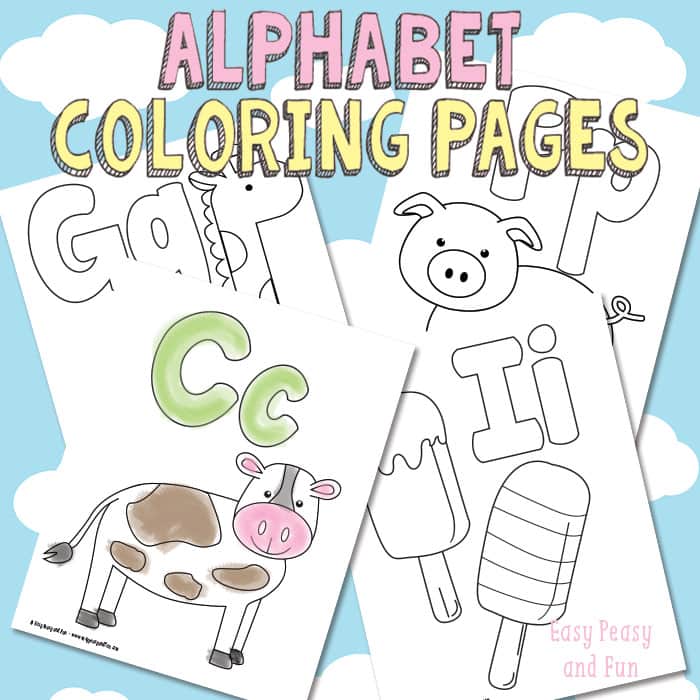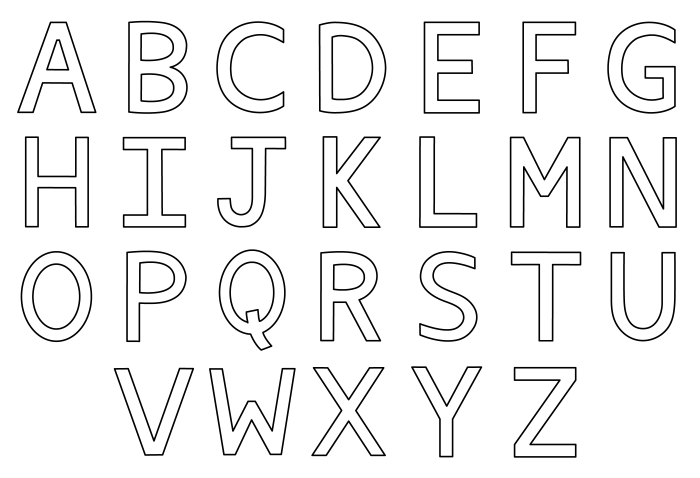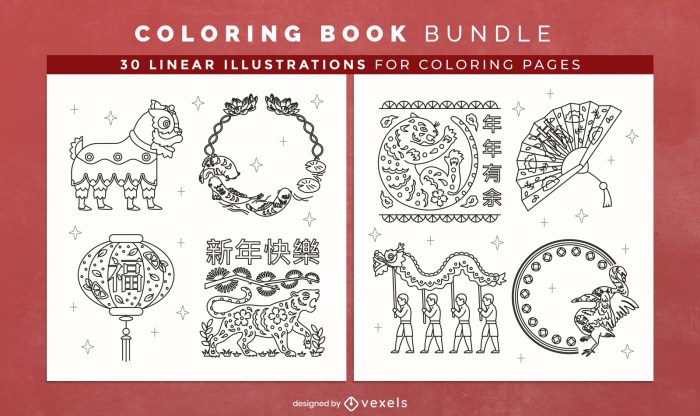Target Audience Analysis

This section details the target audience for an alphabet coloring book printable, considering their age range, interests, skill levels, and the design elements that would best cater to their needs and preferences. Understanding this audience is crucial for creating a successful and engaging product.The primary target audience for an alphabet coloring book printable is preschool-aged children, typically ranging from ages 2 to 5 years old.
This age group is actively developing fine motor skills, hand-eye coordination, and color recognition. Their cognitive abilities are also expanding rapidly, making them receptive to learning through play and creative activities.
Age Range and Skill Levels
Preschoolers in this age range demonstrate varying skill levels in coloring. Some may be proficient in staying within lines, while others are still developing this ability. Therefore, the designs should accommodate different levels of dexterity. Simpler designs with larger areas to color are suitable for younger children, while slightly more complex designs with finer details can challenge older preschoolers.
The designs should also incorporate a variety of shapes and sizes to cater to different levels of fine motor skill development. For instance, a page might feature large, bold letters alongside smaller, more intricate elements within the letterforms, offering a choice of challenge. This approach allows children to choose activities that are both engaging and appropriate for their abilities.
Interests and Preferences
Preschoolers are typically drawn to bright, vibrant colors, and simple, recognizable images. Animals, familiar objects, and characters from popular children’s shows are all highly appealing. The alphabet coloring book should incorporate these elements to make the activity more enjoyable and engaging. For example, the letter “A” could be depicted as an alligator, “B” as a bright blue balloon, and so on.
This association of letters with visually stimulating images helps reinforce letter recognition and vocabulary development. The overall aesthetic should be cheerful and playful to maintain children’s interest.
Effective Coloring Book Design Characteristics, Alphabet coloring book printable
Effective coloring book designs for preschoolers should prioritize simplicity and clarity. Thick, bold Artikels are essential to help children stay within the lines and avoid frustration. Large coloring areas are preferable to smaller, intricate details, especially for younger children. The use of high-contrast colors ensures that the images are easily visible and appealing. Consider incorporating a variety of textures and patterns within the designs to add visual interest and stimulate creativity.
For example, simple patterns like stripes, polka dots, or zigzags could be incorporated into the letterforms or surrounding images. This adds a level of complexity without overwhelming the child. Finally, leaving ample white space around the designs prevents the page from feeling cluttered and overwhelming, making it easier for children to focus on the coloring task.
Printable Format and Functionality

Creating a printable alphabet coloring book requires careful consideration of file format, page layout, and print settings to ensure a high-quality, user-friendly product. The goal is to produce a coloring book that is easy to download, print, and color without experiencing any distortion or loss of quality.Choosing the right file format and designing an effective page layout are crucial steps in achieving this.
We’ll explore the optimal file formats, layout considerations, and best practices for ensuring clear and distortion-free printing.
Optimal File Formats for Printable Coloring Books
PDF (Portable Document Format) is the preferred file format for printable coloring books. PDFs maintain the integrity of the document across different operating systems and printers, ensuring consistent results regardless of the user’s setup. JPG (JPEG) files can also be used, particularly for individual pages, but PDFs are superior for multi-page documents due to their ability to preserve page layout and prevent image compression artifacts that can reduce quality.
Using a high-resolution PDF ensures sharp lines and vibrant colors in the final print.
Printable Page Layout Design
Effective page layout is key to a successful coloring book. A standard letter-size page (8.5 x 11 inches) is generally suitable, offering ample space for lettering and illustrations. Margins should be generous (at least 0.5 inches on all sides) to prevent important elements from being cut off during printing and to provide space for binding if the book is intended to be bound.
Letter placement should be clear, large enough for easy tracing, and strategically positioned to avoid overlapping with illustrations. Consider using a sans-serif font for clarity. Each letter should have ample space around it, preventing crowding and allowing children enough room to color.
Best Practices for Clear and Distortion-Free Printing
To ensure your coloring book prints clearly and without distortion, use a high-resolution image (at least 300 DPI) for all illustrations and lettering. This high resolution prevents pixelation and ensures crisp lines when printed. Avoid using overly complex designs or very small details, as these can become blurry or lost during the printing process. Before printing, always check a test print to ensure that the colors, fonts, and layout are accurate and meet your expectations.
Alphabet coloring book printables offer a fantastic way to learn letters while having fun. Expanding on this, you might also enjoy themed coloring pages, such as coloring book pages of elephants , which can be a great supplementary activity. Returning to the alphabet, these printable books provide a versatile and engaging educational tool for young children.
Using CMYK color mode instead of RGB is recommended for professional printing to accurately represent colors.
Page Layout Options
| Layout Option | Description | Pros | Cons |
|---|---|---|---|
| Single Letter per Page | Each letter of the alphabet occupies a full page, allowing for large, detailed illustrations. | Large illustrations, less crowded, suitable for younger children. | Requires more pages, potentially increasing printing costs. |
| Two Letters per Page | Two letters are presented on each page, typically arranged side-by-side or vertically. | Fewer pages than single letter layouts, efficient use of paper. | Smaller illustrations, may be less suitable for very young children. |
| Multiple Letters per Page (Grid Layout) | A grid layout presents multiple letters on a single page, arranged in a grid pattern. | Very compact, minimizes paper usage. | Smallest illustrations, can feel cramped, may be difficult for younger children to manage. |
| Thematic Page Layouts | Letters are grouped thematically (e.g., animals starting with each letter) on a page. | Engaging, provides context, helps with learning. | Requires more design work, might not be suitable for all age groups. |
Additional Features and Enhancements
Enhancing the basic alphabet coloring book with additional features can significantly increase its appeal and educational value for young children. Adding bonus content and interactive elements transforms a simple coloring activity into a more engaging and enriching experience. Careful consideration of themes also helps to cater to diverse interests and learning styles.Adding bonus content, such as word puzzles or simple games, provides supplementary learning opportunities beyond simple coloring.
These additions help reinforce alphabet recognition and letter sounds in a fun and interactive way. The inclusion of thematic elements can further enhance engagement and learning.
Bonus Content: Word Puzzles and Simple Games
The inclusion of simple word puzzles and games directly related to the alphabet letters significantly increases the educational value of the coloring book. For example, a simple word search puzzle using words beginning with each letter could be included on a separate page. Alternatively, a matching game pairing uppercase and lowercase letters could be designed. These activities reinforce letter recognition and spelling skills, extending the learning experience beyond coloring.
Another possibility is a simple “I Spy” game, where children find objects in the illustrations that start with a specific letter. These interactive elements transform passive coloring into an active learning experience.
Thematic Approaches for Alphabet Books
Choosing a cohesive theme for the alphabet book allows for a more focused and engaging learning experience. Several themes offer opportunities for creative and educational content.
- Animals: Each letter could be represented by an animal starting with that letter (A is for Alligator, B is for Bear, etc.). Illustrations could depict diverse animals in their natural habitats, encouraging learning about different species.
- Objects: This theme could focus on everyday objects, from apples to zebras, introducing children to a range of common items. Illustrations could show the objects in different contexts, prompting discussions about their use and function.
- Foods: This theme could feature a variety of fruits, vegetables, and other foods, introducing children to healthy eating habits. Illustrations could be vibrant and appealing, making the learning experience more enjoyable.
These themes offer a variety of visual and educational possibilities. The selected theme should align with the intended age group and learning objectives. Consider incorporating diversity and inclusivity within the chosen theme to create a representative and enriching experience for all children.
Interactive Elements for Printable Alphabet Books
While a printable book is inherently static, there are ways to incorporate interactive elements to enhance engagement. One approach involves using perforated pages that can be cut out and used for crafting or building simple models. For example, after coloring a letter and its corresponding image (like an ‘A’ for Apple), a simple apple shape could be included on a perforated page for children to cut out.
This adds a tactile and hands-on element to the activity. Another approach is to design pages with elements that encourage children to draw or write, such as adding blank spaces next to each letter for children to trace or draw related images. These interactive features transform the coloring book into a more dynamic and multi-sensory learning experience. Finally, the use of simple mazes or connect-the-dots activities related to each letter could further engage children and develop their fine motor skills.
Image Descriptions: Alphabet Coloring Book Printable
This section provides detailed descriptions of the illustrations for letters A, B, C, X, Y, and Z, aiming to offer sufficient detail for accurate recreation. The descriptions focus on color palettes, artistic styles, and compositional elements. These descriptions are intended for use in creating a printable alphabet coloring book.
Letter Illustrations A, B, and C
The illustration for the letter A depicts a vibrant, anthropomorphic apple. The apple is a deep red, highlighted with lighter shades of red and pink on its rounded surface to suggest highlights and shadows. The stem is a thin, brown twig, slightly curved. The leaf is a bright, kelly green, with darker green veins subtly indicated. The letter A is formed by the Artikel of the apple itself, with the stem and leaf extending beyond the letter form.
The style is whimsical and cartoonish, employing bold Artikels and simplified shading. The composition is centered, with the apple filling most of the space.The letter B is illustrated as a cheerful, blue bumble bee. The bee is predominantly a bright, sky blue, with yellow stripes across its body. The wings are a translucent, pale yellow, with subtle veins indicated in a darker yellow.
The bee’s eyes are large and black, and its antennae are thin, black, and slightly curved. The letter B is formed by the bee’s body, with the wings extending slightly beyond the letter shape. The style is friendly and cartoon-like, using soft, rounded shapes. The composition is slightly off-center, allowing space around the bee.The letter C is represented as a cheerful, orange caterpillar.
The caterpillar is a bright, burnt orange, with a series of small, black legs along its body. Each segment of its body is slightly different in shade, giving it a three-dimensional appearance. The caterpillar has two small, black eyes and a tiny, black mouth. The letter C is formed by the caterpillar’s curved body. The style is playful and slightly realistic, using subtle shading to create depth.
The composition is centered, with the caterpillar gracefully curving to form the letter.
Letter Illustrations X, Y, and Z
The letter X is depicted as a bright yellow xylophone. The xylophone is composed of a series of rectangular bars of varying lengths, painted in alternating shades of yellow and light gold. The bars are mounted on a dark brown frame. The letter X is formed by the arrangement of the bars. The style is simple and realistic, focusing on the texture and color of the wood.
The composition is balanced, with the xylophone centrally placed.The letter Y is illustrated as a playful, purple yo-yo. The yo-yo is a rich, deep purple, with a lighter purple stripe around its center. A thin, silver string is attached to the top. The style is smooth and slightly shiny, suggesting a polished surface. The letter Y is formed by the shape of the yo-yo and its string.
The composition is centered, with the yo-yo prominently displayed.The letter Z is represented as a bright, green zipper. The zipper is a vibrant, lime green, with small, silver teeth. The slider is a small, metallic grey rectangle. The zipper is slightly open, revealing a thin, white lining. The style is detailed and realistic, showcasing the texture and metallic elements.
The letter Z is formed by the shape of the open zipper. The composition is centered, with the zipper extending horizontally across the page.


